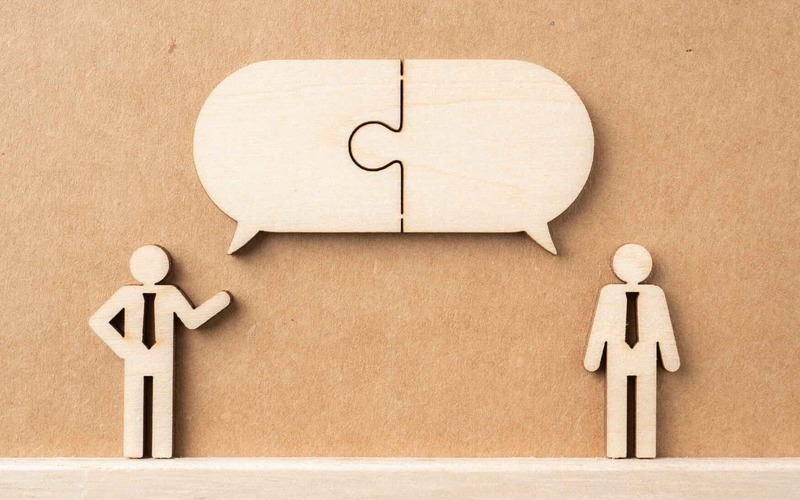Nonviolent communication

How can you stand up for yourself in a connecting way? Communicate clearly and say what's on your mind while respecting the other person? Nonviolent communication is the key to resolving conflict faster, avoiding stress and strengthening your relationships with others.
It is easy to take (nonviolent) communication for granted. After all, we communicate every day and we hardly give it a second thought.
Because we communicate mostly on 'autopilot' things regularly go wrong. Some of the most important stress factors at work arise from frustrations or difficult interactions with colleagues and clients. Many employees are involved in interpersonal conflicts with their coworkers, which causes higher stress and less resilience. (Research by Wacker & Dziobek, 2018).
Much of this stress can be avoided by adopting an understanding and connecting style of communication. In this way, both burnout and colleague-related stress in the work environment are avoided or even prevented.
Numerous consultants, behavioral scientists and business leaders endorse the importance of nonviolent communication and apply it to deepen relationships and strengthen collaboration. What does it show in practice? The quality of communication within a team contributes to better results, higher motivation and less stress.
Nonviolent communication is only successful if you are willing to adjust your mindset as well. Most of us strive for skills such as convincing others, having more impact, communicating more effectively, or achieving our goals faster. We have been conditioned from birth to compete, judge, demand and criticize. We have been taught to think and communicate in terms of what is "right" and "wrong." Result: communication that leads to misunderstanding, misunderstanding and frustration. Or worse: anger, hurt or even violence. And the unfortunate thing is that this usually happens unconsciously and we often cause unnecessary conflict with the best of intentions.
Nonviolent communication with the right intention
Every communication or action is preceded by a thought. How we think, the language we use and the underlying intention determine the importance of nonviolent communication.
If our intention is to get our way or manipulate others, it will be reflected in our communication. And sometimes we do indeed get our way or the result we were seeking - but very often at the cost of putting a firm dent in the relationship or collaboration. You may win in the short term but you end up paying a price for it sooner or later.
If, on the other hand, our intention is to go for a win-win and we are willing to be open to others and flexible in our strategy (without letting go of our needs) - then our communication will automatically create more connection and we will strive for long-term sustainable results.
In that case, it pays to ask yourself to what extent you are able to listen to and understand the needs of others without losing sight of your own.
What are the benefits of nonviolent communication?
Nonviolent communication takes effort, focus and is a conscious choice. Fortunately, the benefits are many:
- Better teamwork and increased efficiency
- Increased productivity at meetings and gatherings
- Less stress and absenteeism
- Quick resolution of conflicts or frustrations
- Personal growth and development
- Greater personal empowerment
- Increased employee morale and loyalty
- More listening so that others are truly heard
- Transformation of company culture
- Transforming criticism and blame into understanding and constructive communication
Communication as a growth factor
The very process of practising connecting communication contributes to more personal growth and development.
Why? Because you become more open to feedback, you gain more insight into your blind spots. Accepting and giving constructive feedback helps you address these blind spots and gain visibility into behavior patterns that are blocking you. When you become aware of these areas in which you can grow and learn then a powerful process of personal fulfillment and self-development begins.
When you don't look at your blind spots and keep reacting in a reactive way to the things that trigger you (and thus are not open for connecting feedback) then you run the risk of falling back into the same old patterns.
Nonviolent communication can help you to get more understanding from your boss or a better relationship with your mother-in-law, with the bonus that you yourself benefit because it helps you in your personal growth and development.
And this also affects your relationships, your family, your friends and everyone you interact with.
Nonviolent communication in practice
Almost every communication arises from a need: you want the other to do something, understand it, remember it, apply it ... When we manage to understand each other at the level of our needs, without communicating criticism, blame or demands, we achieve a deeper connection, our creativity increases and solutions emerge. At this level, conflicts and misunderstandings can be resolved with greater ease.
Nonviolent communication has two parts: expressing ourselves honestly to others and listening empathically to your interlocutor. Both are expressed through four components - perceptions, feelings, needs and requests.
Of fundamental importance is to distinguish these components from judgments, accusations, interpretations and demands. So not, "You are always late" (judgmental and accusatory) but rather, "I would like you to be on time."
Let's take a closer look at the process of perceptions, feelings, needs and requests.
Perceptions
Perceptions are things we see or hear. It is key to describe them as concretely, specifically, and neutrally as possible. This helps to ensure that the context is clear and distinct to both parties.
The key to making an observation is to leave out our own judgments, evaluations or interpretations. For example, if we say, "You're rude," the other person may feel attacked or hurt.
The neutral perception here might be: "When I came in and I said hi, I didn't get a response." Here the other person is more likely to recognize the moment described.
If we are able to neutrally describe what we see or hear without judging, we increase the chances that the person will listen to us and be more willing to hear our feelings and needs without becoming defensive in the process.
Feelings
Feelings represent our emotions and what we feel in our bodies. So in this second stage, we are going to describe what the observation in step 1 elicits in us in terms of feelings. The key to expressing feelings is to focus on words that describe your inner experience and not project interpretations onto the other. For example, "I feel excluded" describes an inner experience, while "I feel like you don't include me in the team" describes an interpretation that you project onto your interlocutor.
When we express our feelings, we make clear to others what is important to us, without criticizing or blaming. This increases the likelihood that they will respond in a more open manner.
Needs
Feelings arise when a need is not met. For example: Jan is late to the meeting for the third time (= perception). I feel annoyed (= feeling) because I think it is important that the meeting can start on time. (punctuality = need) Naming the underlying need automatically creates more connection, because most of those needs are recognizable and universal. Just think of the need for respect, peace, safety,
Requests
The 4th stage in the process of nonviolent communication is to make a request to meet our needs. Remember: a request is not the same as making demands. Therefore, at this point, requests are often "requests for connection," designed to promote understanding and determine if we can move on to a "request for resolution." In the situation where a colleague is invariably late for meetings, an example of a request for connection might be: "Can you understand that this is frustrating for me/the team?" An example of a request for resolution might be: "Can I count on you to be on time next time?"
A request means that you take into account that you may also be told "no." The difference between a request and a demand is often evident in our reaction when our request is rejected. A rejected demand will lead to consequences; a rejected request will usually lead to further dialogue. If we are confident that we can reach a solution through dialogue, "No" is merely information to remind us that the other person's needs have not been met. We can then continue to look for additional strategies to meet those needs more fully.
When formulating a request, it is important to make it as concrete and actionable as possible. For example, "I would like you to always be on time" is probably not actionable, whereas "Is it possible for you to be at the meeting tomorrow at 9?" is concrete and precise.
Learning to make clear requests and not make demands is a big challenge for many. We are used to thinking in terms of what we want people to stop doing ("don't yell at me"), and how we want them to be ("treat me with respect") rather than what we want them to do ("would you be willing to speak more softly?"). This takes time, practice, and a better understanding of your needs.
Empathy
Expressing our own perceptions, feelings, needs and requests to others is one part of nonviolent communication. The second part is empathy: connecting with another by understanding their feelings and needs. Empathy or empathy can be a powerful turning point in a conflict or problem situation. When we show empathy, something magical happens. When we show others that we understand their feelings then often the conflict melts away like snow in the sun. Showing that we understand is not the same as agreeing or being right.
When we show empathy, often a shift takes place, where the other feels more understood, goes less into resistance and is more open to dialogue and solutions.
More information: nonviolent communication





